
Animals With Best Eyesight: Humans have perfect eyesight, all things considered. First of all, we have so-called binocular vision – we can concentrate both of our eyes on an object. This type of vision allows us to see the objects in 3D – not only can we see their shape but also perceive depth.
Humans also can see several colors and can see from a distance. In the best case, humans can see three miles away.
Still, various animals also have good vision. In some cases, their eyes are significantly better in certain aspects compared to ours. Some animals can see more colors than us; others have excellent visuals even underwater; another group of animals uses various adaptations that allow them to navigate the world at night.
Why won’t all animals have the best possible vision?
Because all changes in one’s body come at a price. If you want to have big eyes, you would have to compromise on some other body part to have a reasonable weight.
If you want to have high definition vision – you would need to spend a lot of energy supplying all the nerve cells processing the incoming images. So each pair of eyes, in each creature on this Earth, results from a delicate balance.
Each animal has the type of vision it requires for its needs – no more, no less.
Let us see the variety of visual adaptations among different representatives of the animal kingdom.
Table of Contents
Top 6 Birds with Best Eyesight
birds are famous for their eyesight. The title of the absolute leaders belongs to raptors – still, there are other birds with amazing eyes.
1. Bald eagle – best distance vision

Many of us have heard the phrase “eagle eye“. The bald eagle is an excellent illustration of this comparison.
| Animalia | accipitriformes | Accipitridae | Haliaeetus | Haliaeetus leucocephalus |
According to the experts, the acuity is approximately 7-8 times higher than humans. Bald eagles often hunt fish and track the fish movements from considerable heights despite their masking coloring.
Several adaptations contribute to their acute vision:
- Eagle eyes fill most of their skulls.
- The eagles switch from seeing with one eye (monocular vision) to seeing with both eyes (binocular vision).
- Each eye has two focal points, called foveae. They are organized so that one fovea is directed forward, and another is directed at an angle. This allows the birds to look in two directions simultaneously.
- The density of nerve cells on the back of the eye, the retina, is very high.
- The eagles can keep their head immovable for a time, concentrating on the object, which aids them in getting a clear picture.
- Eagles can see standard colors, as well as in the ultraviolet light spectrum.
![]()
2. Harris hawk – best color vision in a raptor

A harris hawk is a well-known raptor bird, previously often used in falconry. It is middle-sized, with tawny and brown feathers and a curved beak. Harris hawk is currently an object of active research because of the aspects of his vision.
| Animalia | Accipitriformes | Accipitridae | Parabuteo | Parabuteo unicinctus |
Harris hawk, similar to other raptors, have highly acute vision and possesses double fovea. There several types of photoreceptors in the bird’s eyes:
- Single cones that detect violet color;
- Single cones that detect short light waves;
- Single cones that detect middle range light waves.
- Single cones that detect long-range light waves.
- Double cones
As a result, this bird can vividly see at least four colors. Moreover, though the hawk has comparatively small eyes, it can distinguish two objects with different colors (for example, a grey mouse lying on the green grass) with high precision, according to research. This raptor can also register an object at a -fast speed at least 77 Hz, while humans can register objects only at 50-60 Hz.
![]()
3. Tawny owl – best night vision
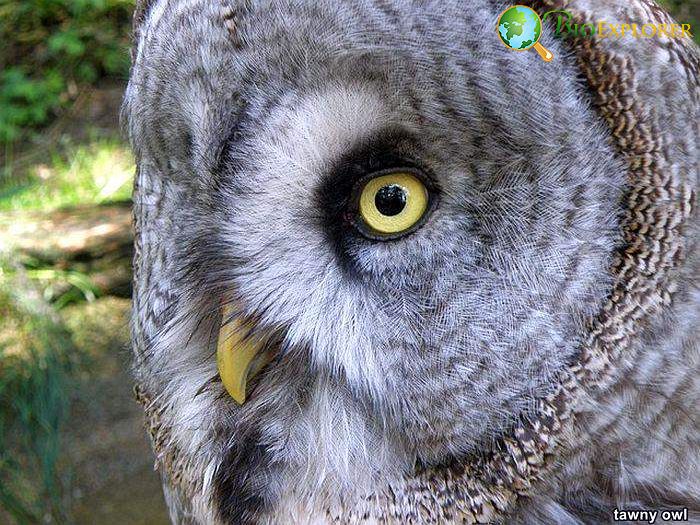
Owls are also effective predators and therefore need quality vision. The tawny owl is a stocky bird, around 40 cm in size, with the mottled brown and grey coloring.
| Animalia | Strigiformes | Strigidae | Strix | Strix aluco |
These birds are predominantly nocturnal. There are several aspects to their vision quality:
- Tawny owls have large eyes located near to each other and have binocular vision.
- Tawny owls have high visual acuity, according to some sources, around 100x sharper than humans. They can spot potential prey around 500 m away.
- Tawny owls can see some colors – they were found to differentiate between red and green or blue and green.
- The owls have tapetum lucidum – a specialized reflective structure in the eye.
- The owl’s eyes fields of vision overlap considerably (up to 70%), which leads to a large binocular field of vision.
- Despite owls being nocturnal, their visual sensitivity in the dark is approximately 2.2 times more significant than human vision due to a larger pupil.
![]()
4. American woodcock – best panoramic vision

An American woodcock is a small bird, up to 30 cm in size, with mottled brown coloring and an incredibly long beak. This bird lives and feeds on land and lives in valley-like areas.
| Animalia | Charadriiformes | Scolopacidae | Scolopax | Scolopax minor |
Because of that, it is very vulnerable to predators and requires good panoramic vision to detect danger. The woodcock can achieve this due to the following:
- American woodcock’s eyes are comparatively large for his skull;
- The eyes of this woodcock are located both high and far on its head.
- Due to the eyes’ location, the American woodcock can see at 350° horizontally and at 180° vertically.
- This is the largest visual field known for a bird at present.
![]()
5. European robin – a unique ability to detect magnetic fields visually.
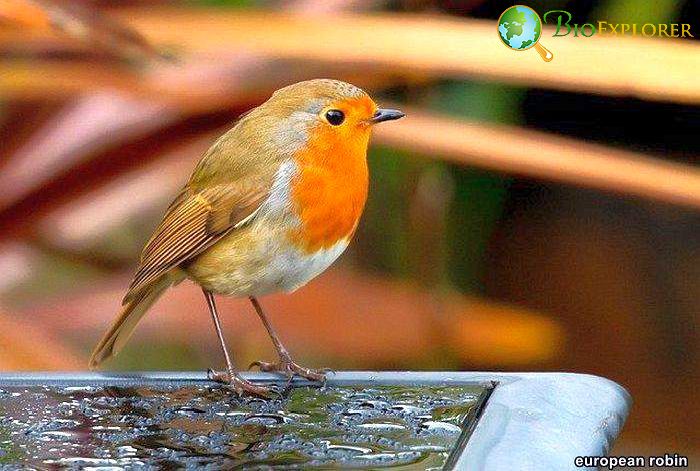
European robin is a small, bright songbird. These birds are easily recognizable by their distinct orange or red breast, while the back and wings are various grey shades.
| Animalia | Passeriformes | Muscicapidae | Erithacus | Erithacus rubecula |
Robins can have a variety of lifestyles. Depending on an area, a robin can either stay for a prolonged time in one place or migrate. In spring, robins tend to migrate at night and require adaptations to orient themselves on the way. Their vision is complex and is dependent on several factors:
- Robins have color vision and have corresponding photoreceptors in their retinas.
- Besides rods and cones, robins also have special cells in the retina that contain specialized molecules – cryptochrome and flavin adenine nucleotide.
- The cells with these chemicals literally enable the birds to see magnetic fields, which helps with night orientation.
- The robins also have a specialized brain region that compiles visual information about the magnetic field, thus enhancing nighttime vision. This brain region is called cluster N and is present only in birds who migrate at night.
Suggested Reading:
What Do Robins Eat? Explore Robin Diets, Hunting & Eating Habits
![]()
6. Broad-tailed Hummingbird – best tetrachromatic vision

Broad-tailed hummingbirds are tiny avian species with a relatively big head, long thin beak, and bright coloring – green and grey wings with iridescent redbreast in males.
| Animalia | Apodiformes | Trochilidae | Selasphorus | Selasphorus platycercus |
Color is essential for hummingbirds, as they predominantly feed on flower nectar. Therefore, they have adapted to see a wide range of colors:
- Besides the regular colors of the rainbow we humans see, they also can see colors outside of the usual spectrum.
- There are three central photoreceptors or cones in the retinas of hummingbirds. Each cone is tuned to catch the specific light wave that corresponds to a specific range of colors: blue, red, and green.
- Besides the regular three receptors, there is also a cone that can detect UV light waves.
- These birds can see their own unique colors because they result from the UV light and one (or more) regular spectral colors.
![]()
Top 5 Mammals with Magnificent Eyesight
Like birds, mammals in the animal kingdom, too, have a splendid vision. In this section, we will explore some of the best mammals with superb eyesight.
1. Cheetah – best vision on the run

Cats’ eyes are some of the most evolved in the animal kingdom.
| Animalia | Carnivora | Felidae | Acinonyx | Acinonyx jubatus |
Cheetahs, the fastest mammals on Earth, are also known for having a vision of the best quality. There are several aspects to cheetah vision:
- Due to the location of their eyes, they have binocular vision.
- Cheetahs can spot prey that is located up to 5 km away.
- To support the prey during the chase, cheetahs have additional structures in their vestibular regions that help them hold their head straight and keep the focus.
- Cheetah’s tear lines absorb sunrays and protect them from being blinded by bright light.
- One reason that cheetah has the best vision in the feline family is that these big cats have the highest density of photoreceptor cells in their retinas than their other relatives.
- Unlike their other cat relatives, cheetahs have poor night vision, as they are daytime hunters.
![]()
2. Domestic goat – best panoramic vision

Virtually everybody has had a goat encounter at least once in their life. And many were probably scared by the goats` eyes at first.
Indeed, the goat’s visual system is unique:
- Unlike the eyes of most mammals, their pupils are horizontal and rectangular.
- The retinas of goats are shaped as rectangles, too.
- Due to this unique shape, goats can have a panoramic vision – their field of vision can reach up to 320-340 degrees.
- Goats also can see at night due to a particular layer in the eyes called tapetum lucidum. This structure reflects the light that comes into the eyes back, “lighting up” the field.
- To see better while grazing, the goat’s eyes can rotate and control their surroundings when they are vulnerable.
- This panoramic vision adaptation comes at a price. The goats have limited color vision. They have only two types of cones in their retinas and decipher only a limited number of colors, including violet, blue, yellow, orange, and green. They cannot really interpret red color.
- The goats have also lost the depth of vision.
![]()
3. Bornean Tarsier – most prominent eyes among mammals
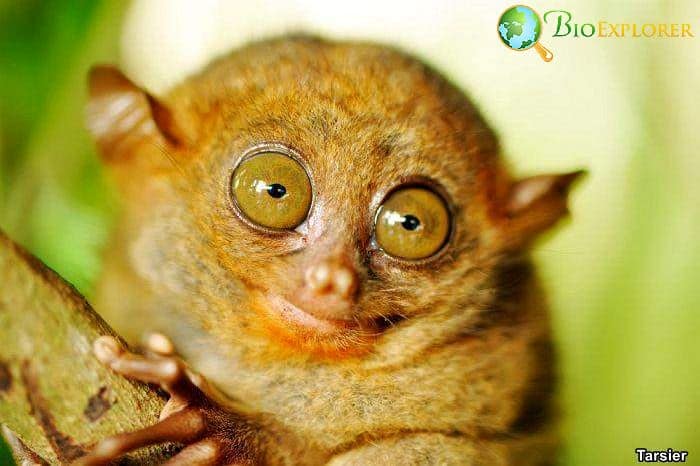
The tarsier is a small primate. It looks a bit similar to lemurs and is active at night. A tarsier is easily recognizable by its large, round eyes.
| Tarsius bancanus |
This feature does not exist just for cuteness – this is an essential adaptation for its nocturnal lifestyle:
- Unlike most nocturnal animals, tarsiers do not have the specialized tapetum lucidum layer that helps other animals like owls, cats, and goats see at night.
- Instead, in the course of evolution, the tarsiers have developed the most enormous eyes among mammals.
- If humans had eyes of tarsier’s proportions, they would be the size of large grapefruits.
- Tarsiers also have an exceptionally high density of photoreceptors in the retina – about 2.5 times more than humans.
- These adaptations allow tarsiers to effectively hunt insects and small reptiles at night.
![]()
4. Arctic Reindeer – best visual adaptations for life in polar regions

As arctic reindeer tend to live in arctic and subarctic regions, they face some unique vision problems. They live in areas covered with snow for prolonged periods, and snow is highly reflective.
Also, regions close to the North Pole have prolonged periods of darkness – polar nights lasting for several months. This means that deer need to orient themselves in semi-darkness always. Because of this, deer have two adaptations:
- Their tapetum lucidum, the reflective structure typical for mammals active at night, changes color in winter. This way, the deer have a golden color in summer and blue eye color in winter.
- The changes in the tapetum lucidum in winter make the eyes more sensitive to light in this period.
- Reindeer eyes can react to UV light as well as standard colors. It is a useful adaptation, as many predators may be undetectable in regular light because of their white fur.
- Fortunately, fur also has a UV signature, and this can be detected by deer eyes.
- As UV light can potentially damage the eyes, reindeer also have protection mechanisms in place that allow them to view ultraviolet light waves relatively safely.
![]()
5. Asian short-clawed Otter – amphibious vision

An otter is a small, sleek mammal that spends a lot of time in the water, fishing for food.
| Aonyx cinerea |
Their vision reflects that:
- Otters have quality vision both on land and in the water, though it is still better.
- The otters’ amphibious vision can be possible due to the specialized focusing mechanism.
- The otters have muscles that change the cornea’s shape, adjusting for the different behavior of light in the water and in the air.
- The otters also have color vision, though they perceive a limited number of colors.
![]()
Top 5 Best Reptiles and Amphibians with Superb Vision
1. Panther chameleon – panoramic binocular vision

A panther chameleon is a beautiful lizard living in the rainforests of Madagascar. Like all species in this family, a panther chameleon has a unique camouflaging ability. Chameleon vision also has some features that can be found only in this group of animals:
| Animalia | Squamata | Chamaeleonidae | Furcifer | Furcifer pardalis |
- The eyes of a chameleon are mounted on conical-shaped turrets.
- The eye of the chameleon can rotate, thus providing the view from the front, to the side, and behind.
- The eyes of the chameleon can move independently from each other.
- The eyes of the chameleon have a muscular, protective lid that allows the eye to protrude from its turret.
- Chameleons can switch from monocular to binocular vision due to the unique nerve organization in the brain.
- Chameleon eyes can discern UV light.
![]()
2. Tokay gecko – best night vision

Tokay gecko is one of the largest geckos in its family. This is a relatively small lizard with cylindrical bodies and powerful limbs. Their skin has a spotted pattern.
- The eyes of the gecko are large, with vertical pupils. The pupil of the gecko’s eye can enlarge and constrict, depending on the light availability.
- Due to this mechanism, geckos have excellent night time vision.
- To further improve the probability of seeing at night, geckos have sensitive photoreceptors (more than 350 large cones ). A short length of the focus – i. e., shot distance between the center of the eye lens and the point of converging for the light beams.
- Geckos also have multifocal lenses. This means that the lens of the gecko has a different point for beams of a different wavelength. This gives the gecko several advantages:
- Several different types of light can focus together on the retina.
- The gecko can focus on objects located at different distances.
- The gecko can get images with two different depths.
This optical system makes the gecko an effective night time predator.
![]()
3. Green Iguana – has a parietal “third” eye
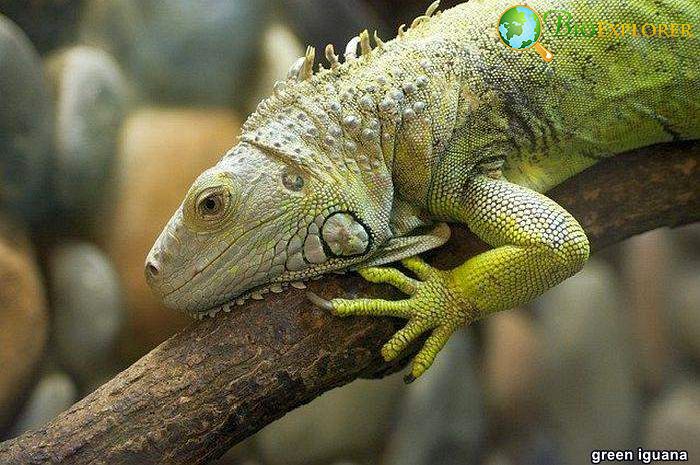
A green iguana is a well-known reptile. It is a green, brown, or grey lizard with a powerful body and legs and a long thin tail.
| Animalia | Squamata | Iguanidae | Iguana | Iguana iguana |
Iguanas also have a typical spiny crest on the head. The eyes of the iguana are yellow, well-defined, and covered with heavy eyelids. These lizards are adapted to finding food in daylight and are relatively slow. Their vision is suited to their lifestyle:
- The iguanas have few rod-like photoreceptors and have low vision in twilight and at night.
- Iguanas have multiple cone photoreceptors and so-called double cone cells that contribute to quality color and contrast vision.
- Iguanas perceive colors more vividly compared to humans, as they predominantly feed on plants.
- Iguanas have an “additional” eye or parietal eye. Its structure is simple, and its primary function is to detect differences between light and dark.
- The parietal eye of the iguanas contains parapinopsin pigment that is sensitive to UV light.
![]()
4. Cascabel rattlesnake – best thermal vision
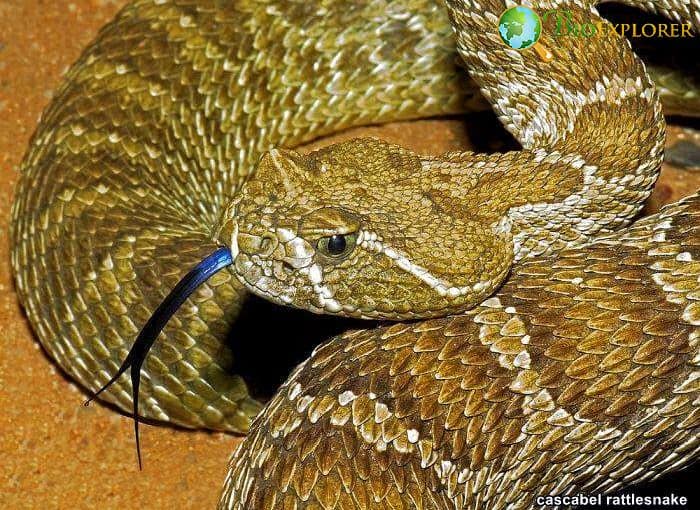
Cascabel rattlesnake is a highly venomous pit viper that can be found in several areas of South America. This snake is relatively big and long, with a diamond-shaped pattern in dark brown or grey color and a typical “rattle” on its tail.
Usually, snakes have relatively poor vision compared to lizards, birds, and mammals. Still, they have an advantage – a developed infrared vision. Rattlesnake infrared vision is considered one of the best due to the following:
- The rattlesnake, like other pit vipers, have so-called pit organs located between the eyes and nostrils.
- Each pit organ contains a membrane with multiple and highly sensitive temperature receptors.
- This pit organ is similar in structure to a pinhole camera.
- The “pinhole” on the visual camera is quite large and so covers a lot of thermal points.
- The information from the heat detection organ and purely visual information is integrated into the particular nerve structure called the optic tectum.
- The obtained integrated image can be even more detailed and accurate than an image obtained with the help of regular mammalian vision.
![]()
5. Common toad – precise motion and color vision at night

A common toad is a large, muscular amphibian with typical “warty” skin. It has large eyes with horizontal pupils. toads and frogs were used as experimental animals by neuroscientists for many years. These animals have a well-developed vision and have both sets of photoreceptors – rods and cones. Recently, toad vision has become especially interesting for scientists.
| Animalia | Anura | Bufonidae | Bufo | Bufo bufo |
It was found that:
- The toads have two types of rod-like photoreceptors.
- There are so-called blue-sensitive rods and green-sensitive rods.
- The pigments in these rods can detect signals even in conditions with low lighting.
- Due to these photoreceptors, toads can detect color at night, finding breeding mates, and assisting in food search.
![]()
Top 4 Best Insects with Ingenious Vision
1. Red dragonfly – multifaceted eyes with multichromatic vision

The red dragonfly is a small insect with a long, thin body and four wings. As the name suggests, the dragonfly has bright red coloring.
It also has large, prominent faceted eyes. Dragonflies are fast and efficient predators, and their vision has developed in a way that helps them in the hunt:
- Dragonflies have compound eyes composed of facets called ommatidia.
- There are several thousand ommatidia in each eye.
- The ommatidia have unique photoreceptor proteins – opsins.
- According to recent research, the red dragonfly has 20 different opsins, each detecting its own light wavelength.
- Opsins are arranged across the ommatidia in a particular order to make detecting objects easier.
- Due to the organization of the dragonfly eye, these insects can see significantly more colors than humans.
- Dragonflies also possess a large field of vision.
![]()
2. Striped horsefly – multicolored compound eyes that can detect polarized light.
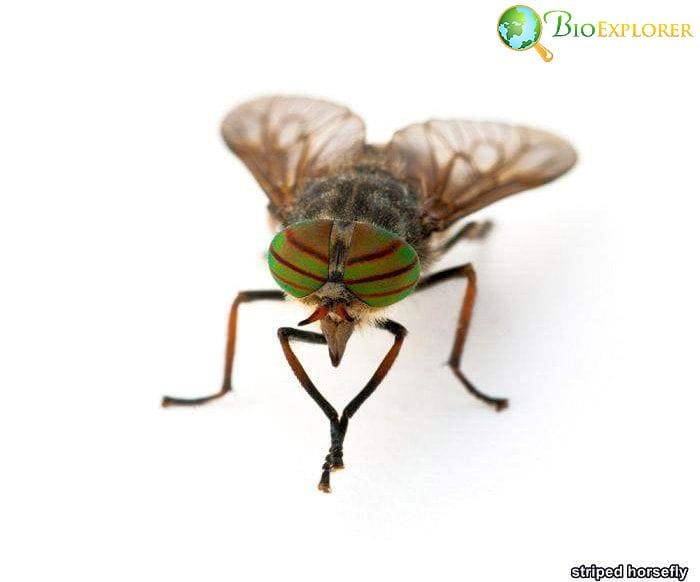
Striped horseflies are a part of the family Tabanidae. These flies are widely known as cattle pests.
| Animalia | Diptera | Tabanidae | Tabanus | Tabanus lineola |
The females of these species feed on mammalian blood to lay eggs. Because of this, these flies also can transmit blood-borne diseases. These flies are small and do not have unusual coloring except for the eyes. Usually, the eyes of the horsefly have stripes in several colors. The compound eyes of these insects have several exciting features:
- The eyes of the horsefly have ommatidia of different sizes: upper eye parts are composed of large ommatidia, while the lower eye part with stripes have smaller ommatidia.
- The organization of the pigments in the horsefly eyes allows them to detect camouflaged animals.
- Horseflies can detect polarized light, which helps them with finding water to lay eggs.
- The affinity of the horseflies for polarized eyes can be used against them – painting stripes on the cattle bodies can prevent the flies from landing on them.
![]()
3. Common bluebottle butterfly – the highest diversity of color detection in insects
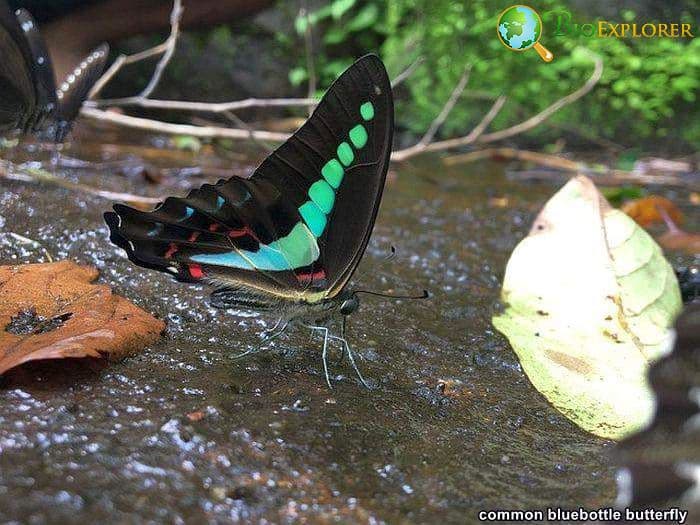
The bluebottle butterfly or blue triangle butterfly lives in Australia.
As the name suggests, the butterfly has a pattern that resembles a bright blue triangle on the black background. In general, butterflies have a well-developed color vision as they rely on flowers for food. The bluebottle butterfly is unique among its relatives in this regard because:
- The butterflies’ ommatidia have nine receptor cells each.
- Each ommatidia has its own different properties and contains different pigments.
- All the photoreceptors in the bluebottle butterfly can be classified into six classes: red, blue, green, ultraviolet light, violet, and blue-green.
- There are 15 types of photoreceptors in total in those classes.
- Because the butterflies have eyes with at least three different types of ommatidia and 15 different types of photoreceptors, the ability of these insects to detect color shades and properties is very well developed.
Suggested Reading:
Top 21 Facts About Blue Morpho Butterfly
![]()
4. Sunburst diving beetle – larvae with bifocal eyes

Sunburst diving beetle is a small insect that lives in lakes and rivers in North America, in the region that encompasses California, Texas, and Arizona.
| Animalia | Coleoptera | Dytiscidae | Thermonectus | Thermonectus marmoratus |
The beetle has a noticeable pattern of bright yellow spots on the black background. The vision in the adult beetle is not remarkable, while the eyes in the larvae have attracted scientists’ attention:
- The sunburst diving beetle’s larva has 12 eyes in total, 6 eyes on each side of the head.
- Four of these eyes are tubular and are directed forwards.
- These four eyes are “principal eyes” and have two retinas instead of one.
- The retinas are composed of at least 12 tiers of photoreceptor cells.
- Two retinas act as bifocal lenses and can be used to change the sharpness of the image.
- The sunburst beetle’s larvae are predators and hunt in the water, so the unique eye structure helps them track their prey better.
![]()
Top 6 Best Aquatic Animals with Amazing Visual Adaptations
1. Mantis shrimp – best color vision in the animal kingdom

Mantis shrimp is a crustacean that is not actually a real shrimp. This animal is small and prefers warm, shallow waters in the tropics.
| Animalia | Stomatopoda | Squillidae | Squilla | Squilla empusa |
Mantis shrimps have small thin appendages and are remarkably quick. They also have noticeably large, round eyes situated on stalk-like structures. The eye of the mantis shrimp has several unique features:
- Mantis shrimp eyes are rotating and are always in motion.
- There are three regions in the mantis shrimp’s eye: upper and lower hemisphere and a dark band in the middle.
- The mid-band of the mantis shrimp can have 12-16 photoreceptors in total.
- As a result of this complex structure, mantis shrimps have multiple channels of color vision and also can detect polarized and UV light.
- The eyes of this crustacean work similar to a video camera or a satellite.
- Mantis shrimp has a unique nerve structure called a reniform body that allows the animal to process complex visual information.
![]()
2. The common octopus – polarized vision without a blind spot

Octopus is considered to be one of the most developed invertebrates. Its eight tentacles are capable of complex movements.
| Animalia | Octopoda | Octopodidae | Octopus | Octopus vulgaris |
Octopi are excellent at camouflage and are effective predators. This means they also have good vision underwater with the following features:
- The eyes of the octopus are relatively larger and can reach up to 20 mm in diameter.
- Octopi have single-chambered eyes with spherical lenses.
- The retina of the octopus is everted and has simpler photoreceptors compared to vertebrates.
- Pupils in the octopus are mobile – they can grow large and also become reduced to slits.
- The eyes move independently, and the octopus has small binocular vision and large separate visual fields for each eye.
- The retina in the octopus is organized in such a way that there is no blind spot for the eyes.
- The photoreceptors in the octopus are structures in a way that allows the animal to detect polarized light.
- According to recent research, octopus’ eyes are quite sharp and could be compared to cats in this regard.
- Octopi are colorblind, but their ability to change the shape of their pupil and iris and the structure of the photoreceptors allow them to see polarized light and distinguish color changes.
![]()
3. Giant Squid – most prominent eyes in the world

A giant squid is also a cephalopod. It has a different body plan compared to the octopus. This invertebrate is quite large and resides in the deep ocean.
| Architeuthis dux |
Not only is this animal gigantic – some individuals can reach up to 39 feet – it also has enormous eyes:
- Giant squid’s eyes can be as big as a human head.
- The eyes look a bit like human ones, with a vast pupil.
- Squid eye structure is not suitable for detecting prey or mates with accuracy.
- Squid eyes are adapted for the environment with a considerable lack of light.
- Giant squid eyes are mainly capable of detecting shapes.
- According to a recent theory, the squid’s large eyes have explicitly evolved to look out for sperm whales, their main predators.
- The large eyes allow the squids to detect the sperm whale shadow at a distance of 120 m.
![]()
4. Four-eyed fish – sees both above and underwater.
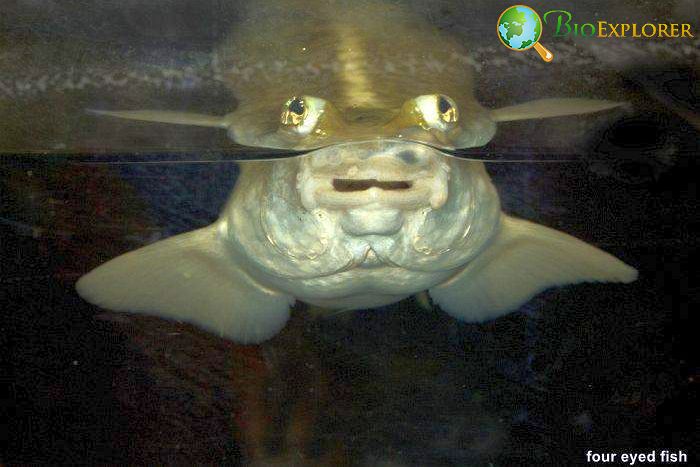
The small, almost transparent four-eyed fish lives in the American tropics.
| Animalia | Cyprinodontiformes | Anablepidae | Anableps | Anableps anableps |
It is mainly the river dweller. Anableps have unique eyes:
- Anableps eyes are large and bulging.
- The pupil in each eye is divided, so it looks as if the fish has four eyes instead of two.
- There is an incomplete bone “plank” in the orbit of the fish cranium that divides the eye in two.
- The pupils and cornea in the Anableps eyes are duplicated.
- There are different photoreceptors in the upper and lower parts of the divided eye.
- The upper part of the eye is adapted to seeing above water, while the lower part is adapted to underwater vision.
![]()
5. Banded Archerfish – the most acute vision in the freshwater fish

The banded archerfish is a small silver-colored fish with distinct black bands. It lives in brackish water in the Indo-Pacific region, mainly in mangrove forests and river mouths.
| Animalia | Perciformes | Toxotidae | Toxotes | Toxotes jaculatrix |
The archerfish has a unique hunting strategy – it shoots its prey down with a stream of water, basically “spitting” at it. To do this, the archerfish has evolved a very complicated vision:
- The archerfish eyes can detect small prey in the air on the complex background, with leaves and other objects.
- The archerfish needs to detect the prey from underwater.
- There are different types of photoreceptors with different sensitivity in the different areas of the archerfish eye, thus making it able to discern objects in the air and underwater.
- The archerfish have very high visual resolution.
- The archerfish has a particular area, area centralis, that helps it to process images in high resolution.
- The acuity of the archerfish is 3.5 cycles per degree. In comparison, the acuity of other fish species is less than 1-2 cycles per degree.
![]()
6. Box Jellyfish – multiple different eyes

A box jellyfish belongs to a group of invertebrates called cnidarians. It has a straightforward body plan – just a cube-like soft transparent body and multiple tentacles.
Jellyfish do not have a complicated brain either – just several nerve clusters. Instead, they have a unique visual system:
- Jellyfish have six eye clusters.
- Each eye is basically a hole with a pigment.
- Each eye has a lens that has different properties at the edges and in the center, thus focusing each wave of light at a certain point.
- The eyes can also be divided into groups for specialization.
- For instance, there are 4 eyes specialized for detecting images above the water surface.
![]()
As you see, the eyes with various marvelous features have evolved in all kinds of animals. The exciting thing is, not all animals need highly colorful or detailed vision. For example, box jellyfish do not need sharp images to orient themselves, while snakes can hunt successfully without detecting color.
Still, all animals have a vision that suits their particular needs, helping them find food and protect themselves in a complex world with multiple signals and dangers. Human eyes also have features that were needed by our ancestors to survive.
There are no “better” or “worse” eyes. All kinds of vision are necessary for particular circumstances and are a constant source of wonder.
![]()



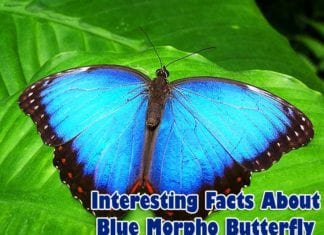





















A very interesting piece thank you. If you are to avoid being bothered again by pedantic physicists like me, at the start of the piece you say that “In the best case, humans can see three miles away.” I am tempted to ask what is it that humans can see three miles away? After all, I can easily see the sun and that is 94 million miles away.
Yours, pedantically,
Sean
Hi Sean,
That’s an intriguing question. Here’s an explanation for 3-mile reference:
According to the ‘Relativity of Wrong’ article by Isaac Asimov (Vol-14) in 1989, our earth curves about 8 inches per mile (i.e., 0.000126 per mile). Therefore, on a flat surface with your eyes 5 feet or so off (average human height), the ground, the most faraway edge you can observe, is about 3 miles away. So this is a scientific fact, and that’s what we quoted in the introduction. Hope it makes sense.
Thanks for the question. Have a great day!